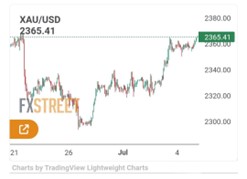The US dollar is continuing to nurse its wounds, brushing off a little increase in the yields on US Treasury bonds, while the gold price is stabilizing close to its two-week high of $2,365 hit on Wednesday. The crucial Nonfarm Payrolls report and the US traders’ return from the July 4 holiday are two events that the gold price is anticipating with interest.
XAU/USD Technical Overview

With risks pointing north after gold broke this week’s consolidation to the upside and closed Wednesday above the crucial 50-day Simple Moving Average (SMA) at $2,338, the short-term technical prognosis for the price of gold is essentially unchanged.
A poor US jobs data might give the bullish breakout more impetus, pushing the price of gold closer to the $2,400 mark.
Gold purchasers will first need to overcome the June high of $2,389 as well as the prior two-week high of $2,369, though.
The bullish potential is also supported by the 14-day Relative Strength Index (RSI), which is pointing north over the 50 mark.

On the other hand, the price of gold may be dragged toward the immediate support of the 50-day SMA, which is currently fixed at $2,340, by robust US NFP data and heated wage inflation.
If the selling pressure picks up, gold sellers can next flex their muscles for the 21-day SMA around $2,328. A persistent dip below the latter might quicken the losses in the direction of $2,300.
Fundamental Overview
Due to limited liquidity, the US celebrated Independence Day on Thursday, which helped the gold price stay elevated and close to two-week highs. As UK voters headed to the polls, trade activity around the customary safe-haven Gold price was restrained, further unsettling the markets.
The US Federal Reserve (Fed)’s (the Fed) rising dovish expectations for interest rate reduction this year have hurt the greenback even more. This came to light after Federal Reserve Chair Jerome Powell recognized earlier this week’s progress in deflation. Further supporting the Fed’s policy pivot bets were many recent US statistics, which showed that private sector employment in the US increased by 150,000 in June after increasing by 157,000 (updated from 152,000) in May.
On the other hand, according to Labor Department data issued on Wednesday, the number of Americans submitting first-time jobless claims increased by 4,000 last week to 238,000. The number was somewhat higher than the 235,000 forecasts. Last but not least, the US ISM Services PMI dropped into the contraction zone in June, scoring 48.8 as opposed to May’s 53.8 and the forecast 52.5 report.
Based on the CME FedWatch tool, traders are pricing in a 73% chance of a decrease in September. Additionally, two possible rate cuts this year are priced in by the markets.

All eyes are now focused on the highly anticipated US labor market data, which is scheduled for release later this Friday at 12:30 GMT. This report could significantly affect how the market prices the Fed rate cuts, which in turn affects the value of the US dollar and the price of gold.
US Nonfarm Payrolls are predicted to increase by 190K in June, following a 272K increase in May, while Average Hourly Earnings are predicted to expand by 3.9% yearly, after previously rising by 4.1%. A rate drop in September would be certain if these important data sets provide results that are lower than those predicted by the market. This would support bets on two Fed rate cuts this year. In a situation like this, the US Dollar is probably going to encounter a new supply, which will give the price of gold another boost.
But if the headline NFP and the wage inflation statistics surprise to the upside and investors reduce their dovish Fed forecasts, the Greenback might climb sharply. This would result in a decline in the price of non-interest-bearing gold.



















